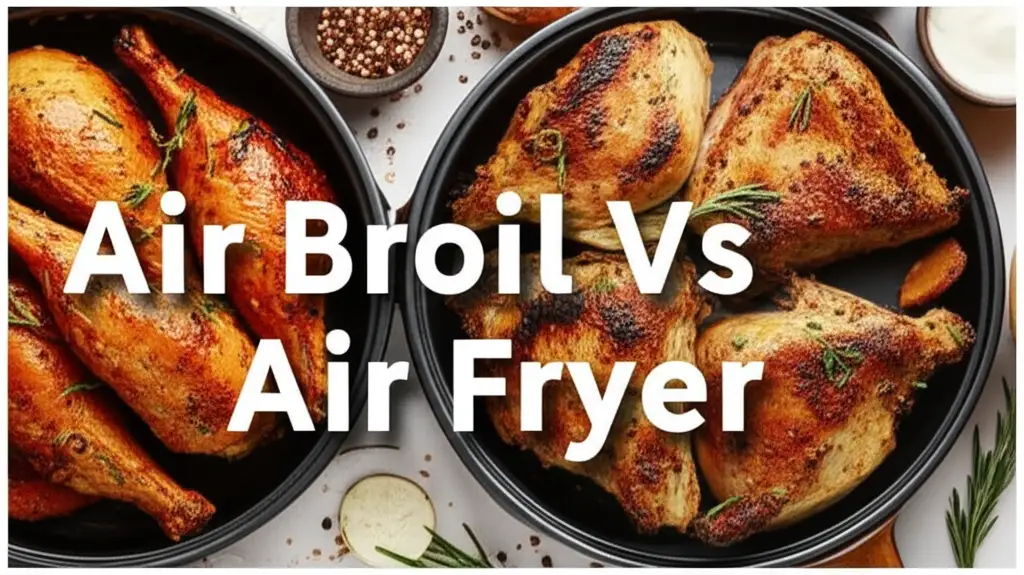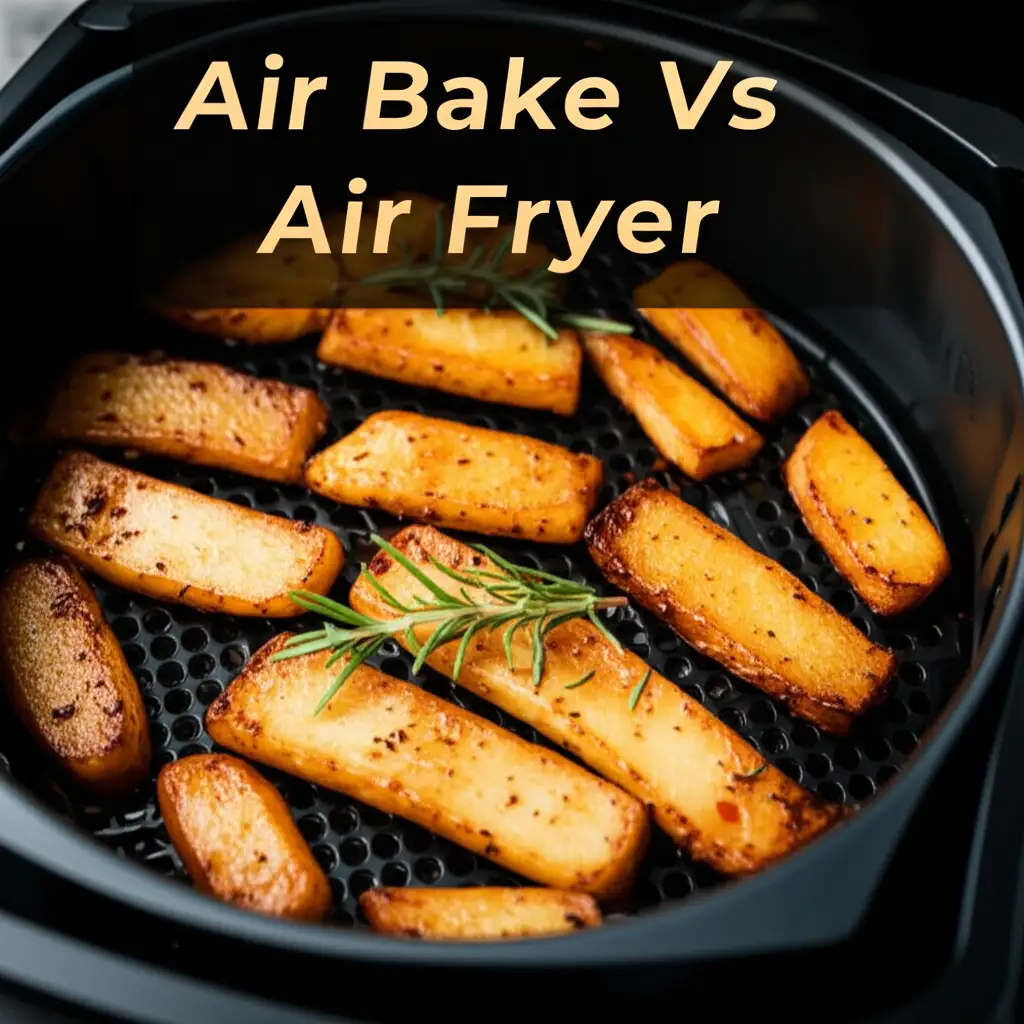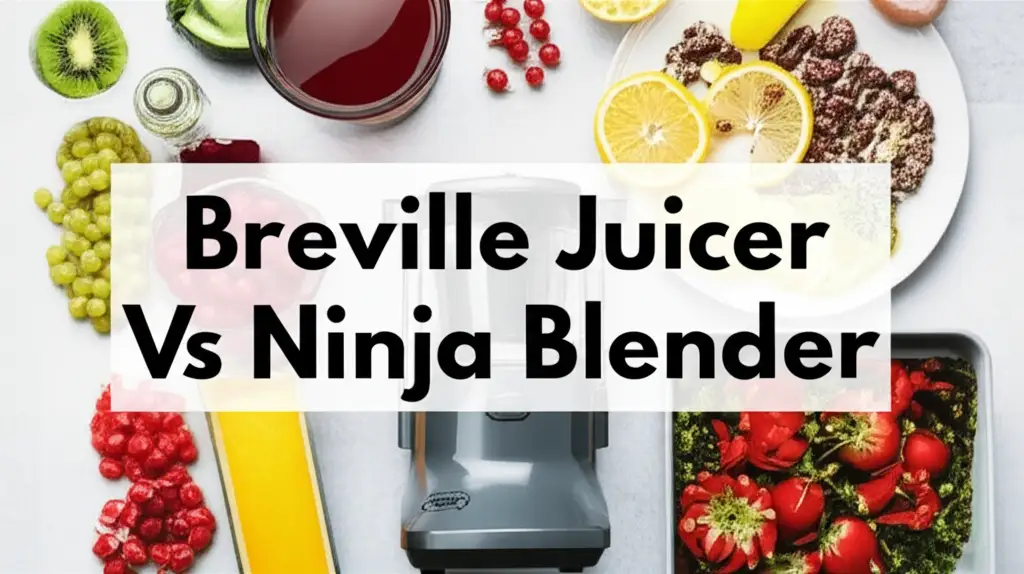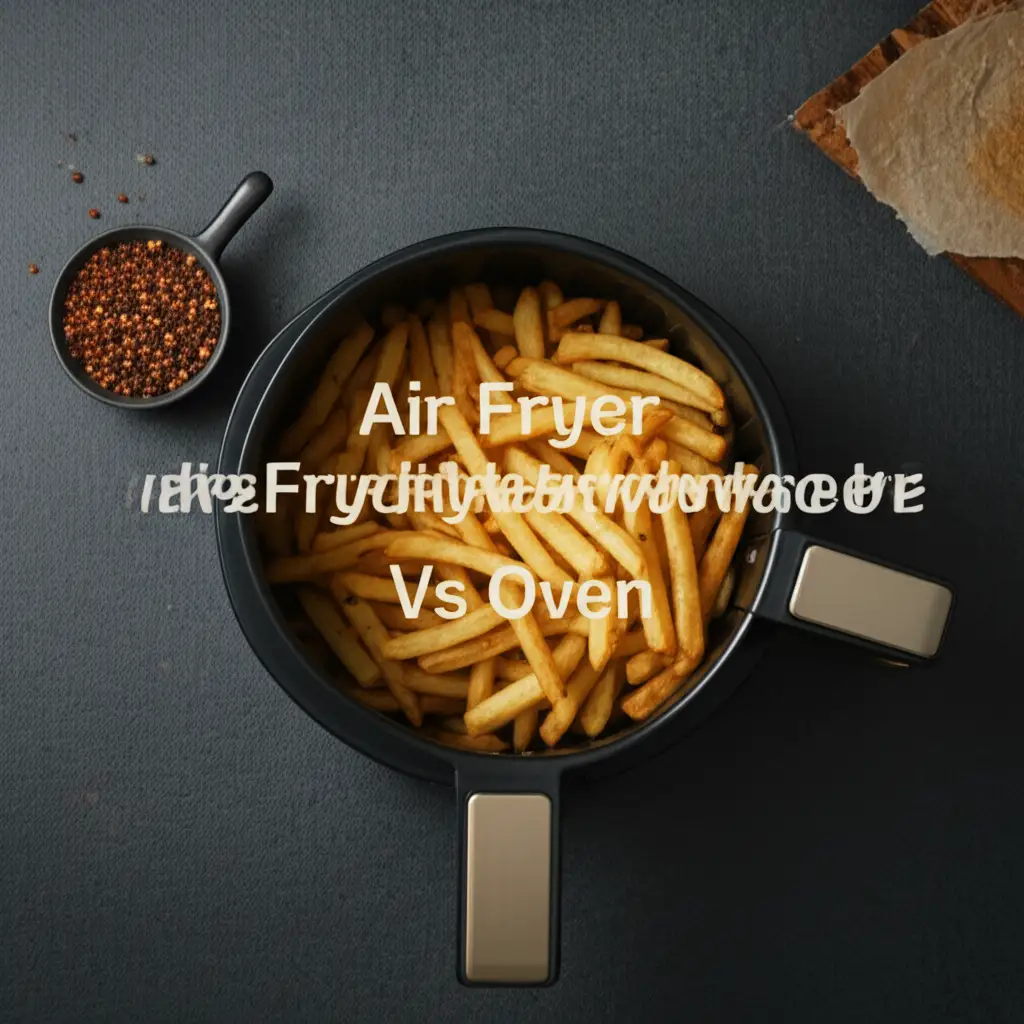· Elira Thomsen · Kitchen Appliances · 17 min read
Air Broil Vs Air Fryer

Air Broil vs. Air Fryer: Which Reigns Supreme for Your Kitchen?
Cooking at home feels great, but sometimes choosing the right tool for the job can be confusing. Many modern kitchens now feature appliances that promise faster, healthier ways to prepare food. You might wonder about the difference between air broil vs air fryer functions, especially if your appliance offers both. I often get asked if these two settings are the same, or if one is simply better than the other.
Understanding the core differences between air broiling and air frying helps you cook your favorite foods perfectly. Each method uses heat in a unique way to create distinct textures and flavors. This article will explain how each function works, what foods they cook best, and which one might be right for your cooking goals. We will look at energy use, cleaning, and overall convenience to help you make smart choices in your kitchen.
Takeaway
- Air Frying: Uses circulating hot air for crisping and even cooking, similar to deep frying but with little oil. Best for snacks, vegetables, and chicken.
- Air Broiling: Applies direct, intense heat from above for browning, charring, and melting. Best for thin meats, finishing dishes, or toasting.
- Choice Depends: Select your method based on the texture you want: crispy and cooked through (air fry) or browned and slightly charred (air broil).
Clear and Concise Answer to the Main Query
Air frying cooks food by circulating hot air, creating a crispy exterior like deep frying but with less oil. Air broiling uses intense, direct top heat to brown and caramelize food quickly. The best method depends on whether you seek overall crispiness or a seared, browned finish.
Understanding Air Frying: The Science of Crispy Goodness
Air frying has become a kitchen favorite for good reason. It offers a way to enjoy crispy foods without much oil. I find it amazing how a simple appliance can transform something soft into a golden, crunchy delight. Let me tell you how it works.
An air fryer uses a powerful fan and a heating element to cook food. It circulates hot air rapidly around your food, similar to a convection oven but on a smaller scale. This hot air movement cooks the food evenly and quickly. The fast air flow also creates a Maillard reaction, which gives food that desirable browned, crispy texture. This process mimics the effects of deep frying, but it uses only a fraction of the oil, sometimes none at all. I love how it can make frozen french fries taste like they came from a restaurant.
Many types of food truly shine when air fried. Think about chicken wings, which turn out incredibly crispy with juicy interiors. Frozen snacks like mozzarella sticks or spring rolls also cook perfectly in an air fryer, becoming crunchy on the outside. Even fresh vegetables, like broccoli or Brussels sprouts, get a lovely char and tender inside. I often use my air fryer for quick weeknight meals when I want something fast and delicious.
The main benefits of air frying include reducing the amount of fat you use in cooking. This makes meals healthier without sacrificing taste. Air fryers also cook food much faster than a traditional oven. They are often smaller, so they preheat quickly, saving you time and energy. Plus, the quick cooking time means less waiting for dinner.
Deciphering Air Broiling: Achieving Golden Perfection
While air frying focuses on all-around crisping, air broiling has a different goal. It aims for intense browning and charring. When I want a quick golden finish on my food, I turn to the broiler. It is a fantastic tool for specific cooking tasks.
Air broiling, whether in a dedicated appliance or a multi-function oven, uses direct, intense heat from a heating element located at the top. This is the same principle as a traditional oven broiler. However, “air broil” implies that a fan might also be active, helping to circulate the super-heated air around the food. This dual action can speed up the browning process even more and ensure a slightly more even char. The heat is very strong, so food cooks or browns very quickly. I always keep a close eye on my food when using this setting.
Certain foods are perfect for air broiling. Thin cuts of meat, like steak or fish fillets, get a beautiful sear and crust. This method also works well for melting cheese on top of casseroles or nachos. If you want to toast bread quickly or brown the top of a gratin, air broiling is ideal. It adds a lovely caramelized layer that enhances flavor. I enjoy making quick garlic bread under the broiler; it gets perfectly toasted in minutes.
The benefits of air broiling are its speed and its ability to create a high-heat browning effect. It is perfect for finishing dishes that need a crisp top or a melted, bubbly cheese layer. It gives food an appealing look and texture that other cooking methods cannot easily achieve. It is not about cooking food all the way through as much as it is about adding that final, crucial touch.
Key Differences: Air Broil Vs Air Fryer Mechanics
Understanding how air broiling and air frying work individually is one thing. Seeing how they differ side-by-side really clarifies their purpose. They both use heat, but their methods are quite distinct. Let me break down the main mechanical differences between air broil vs air fryer.
The primary difference lies in the direction and intensity of the heat. An air fryer primarily uses convection, which is the movement of hot air. A powerful fan circulates this hot air evenly around the food from all sides. This consistent, all-around heat cooks the food thoroughly and creates a crispy outer layer. Think of it like a miniature convection oven. I visualize a whirlwind of hot air cooking my food from every angle.
On the other hand, air broiling uses radiant heat. This means heat comes directly from a heating element, usually located at the top of the cooking chamber. The heat is very intense and direct, similar to grilling but from above. While some “air broil” settings might use a fan to distribute this intense heat slightly, the main action is still direct browning from the top. It is like putting your food right under a sun lamp, but a very hot one.
Consider the role of airflow. Air frying depends heavily on continuous, strong airflow for even cooking and crisping. Without good airflow, an air fryer would just be a small oven. Air broiling, while it might use some air movement, relies more on the direct, high temperature from the heating element. Its goal is to char and brown the surface, not to cook through evenly with circulating air.
Here are the key distinctions:
- Heat Source:
- Air Fryer: Heating element combined with a powerful fan for circulating hot air.
- Air Broiler: Direct, intense heat from a top heating element, often with minimal or gentle fan assistance.
- Heat Direction:
- Air Fryer: Hot air circulates around the food, cooking from all sides.
- Air Broiler: Heat comes primarily from above, targeting the top surface of the food.
- Primary Action:
- Air Fryer: Cooks food through while creating an all-over crispy texture.
- Air Broiler: Browns, sears, or caramelizes the surface of food.
- Temperature:
- Air Fryer: Typically 300°F to 400°F (150°C to 200°C).
- Air Broiler: Very high, often 450°F to 550°F (230°C to 290°C), or simply “Broil” setting.
These mechanical differences mean that air broiling and air frying are suited for different cooking outcomes. Knowing this helps you pick the right setting every time.
Best Dishes for Each Method: When to Air Fry and When to Air Broil
Knowing the mechanics is helpful, but applying that knowledge to your daily cooking makes all the difference. I always think about the texture I want for my food before choosing a setting. This is crucial when deciding between air broil vs air fryer.
Let’s talk about foods that truly excel in an air fryer. If you want something universally crispy, the air fryer is your friend.
- Frozen snacks: French fries, tater tots, chicken nuggets, fish sticks, and onion rings become incredibly crispy, just like deep-fried versions. I never use my oven for these anymore.
- Breaded items: Mozzarella sticks, breaded shrimp, or chicken tenders get that perfect crunch without soaking in oil.
- Vegetables: Roasting vegetables like Brussels sprouts, broccoli, or cauliflower in the air fryer gives them a fantastic slightly charred exterior and tender inside. They cook much faster than in a regular oven.
- Chicken: Wings, drumsticks, or thighs come out with wonderfully crispy skin and juicy meat.
- Reheating leftovers: Pizza, spring rolls, or fried chicken can be made crispy again, far better than a microwave.
Now, let’s look at what the air broil function does best. The high, direct heat is ideal for specific finishing touches or quick cooks.
- Thin cuts of meat: Steak, lamb chops, or pork chops get a beautiful, quick sear and develop a flavorful crust. Since the heat is so intense, these cook fast.
- Fish fillets: Salmon or cod fillets can be broiled quickly to achieve a flaky texture with a nicely browned top.
- Toasting and melting: Making garlic bread, melting cheese on nachos or casseroles, or browning the top of a macaroni and cheese dish is perfect for the broiler. I often use it to give a golden finish to gratins.
- Vegetables for char: If you want a quick char on bell peppers or tomatoes, the broiler does it well. This is great for salsas or just adding a smoky flavor.
Sometimes, you might even use both functions for one dish. For example, you could air fry chicken pieces to cook them through and make them mostly crispy. Then, if you want extra browning or char on the skin, a quick minute or two under the air broil setting can give that perfect finish. This dual approach can maximize both crispiness and browning. It gives you the best of both worlds.
Energy Efficiency and Convenience: A Practical Comparison
When I choose kitchen appliances, I think about more than just cooking performance. How much energy do they use? How easy are they to clean? These practical questions matter. Comparing air broil vs air fryer in terms of efficiency and convenience helps make a smart decision.
Air fryers are generally known for their energy efficiency, especially for smaller meals. They preheat very quickly, often in just 3-5 minutes. This is much faster than a large oven. Because their cooking chamber is small, they need less energy to heat up and maintain temperature. For cooking a batch of fries or a couple of chicken breasts, an air fryer uses significantly less power than a full-sized oven. This saves electricity and reduces your utility bills over time. I notice a difference in my kitchen’s heat too; the air fryer does not warm up the entire room like my oven does.
Air broiling, whether in a dedicated unit or as a setting on a larger appliance, also heats up quickly. However, because it often uses very high temperatures, it consumes a burst of energy during its short operation. For quick tasks like melting cheese or toasting bread, the energy use is minimal because the cooking time is so brief. If you are broiling something for longer, like a thick steak, it might use more energy than air frying a similar amount of food. The efficiency of broiling comes from its speed for specific tasks.
When it comes to convenience, air fryers often have removable baskets or trays. These parts are usually non-stick and can be easy to clean by hand. Some models even have dishwasher-safe components. This makes cleanup much simpler. I always check if my air fryer basket can go in the dishwasher, as this saves me a lot of time. Many users wonder, “can you put the air fryer basket in the dishwasher?” The answer is often yes, which is a big plus for convenience. Also, many air fryers are compact, fitting easily on a countertop.
Broilers, especially those in full-sized ovens, can be harder to clean. Splatters from high-heat cooking can bake onto the oven walls. If you have an appliance with an air broil function, the cleaning might be simpler if the cooking space is smaller. For standalone units, their design often makes them easier to wipe down. Think about what parts touch the food and how accessible they are. Regular cleaning is important to keep any appliance working well. My cleaning routine for air fryer parts is usually quite simple, thanks to their non-stick surfaces.
Safety Considerations and Maintenance Tips
No matter what kitchen appliance I use, safety is always my top concern. High heat cooking, whether air broiling or air frying, requires careful handling. Proper maintenance also ensures your appliance lasts longer and works best.
For both air fryers and appliances with an air broil function, heat safety is paramount. These devices get very hot, both inside and on their exterior surfaces. Always use oven mitts when handling baskets or trays. Place your appliance on a heat-resistant surface, away from walls or flammable materials. I always make sure there’s enough space around my air fryer for proper ventilation. Never block the air vents on any cooking appliance; this can cause overheating.
Cooking with fat can also pose a risk. While air frying uses less oil than deep frying, some foods can still release fat. If too much fat accumulates, it can smoke or even cause a small fire. Always ensure your food is not over-oiled. If you are cooking fatty foods, consider adding a slice of bread at the bottom of the basket to absorb excess grease. This helps prevent smoke and makes cleanup easier.
Regular cleaning is vital for both safety and performance. For air fryers, food particles and grease can build up over time. This not only affects the taste of your food but can also become a fire hazard. After each use, I let the appliance cool down completely. Then, I remove the basket and wash it thoroughly. Many air fryer baskets and trays are designed to be dishwasher safe, which simplifies the process. I often wonder, can my Ninja air fryer basket go in the dishwasher? For most modern models, the answer is yes, making cleanup a breeze.
For cleaning the main unit, I wipe down the interior and exterior with a damp cloth. I pay attention to the heating element and fan area. Sometimes, food residue can stick there. For tough grease, a paste of baking soda and water can work wonders. Remember to unplug the appliance before cleaning it. For more detailed instructions, you can often find guides on how to clean an air fryer oven or general tips for air fryer cleaning. Regular care keeps your appliance working efficiently and safely for many years. Keeping the parts clean, like the main basket, is important. Knowing can you put the air fryer basket in the dishwasher really helps streamline cleaning.
Choosing Your Appliance: Standalone vs. Combination Units
Deciding between a standalone air fryer, a standalone broiler, or a combination unit can be tough. I think about my kitchen space, my cooking habits, and my budget. Each option has its own pros and cons.
A standalone air fryer is a compact countertop appliance. It is perfect if you mostly want to air fry snacks, side dishes, or meals for one or two people. These units are typically affordable and very efficient for their primary task. They heat up fast and are easy to move around. If your current oven lacks a good broiler or convection setting, a dedicated air fryer is a great addition. I love that it does not heat up my entire kitchen.
A standalone broiler is less common as a separate appliance for home use. Most homes have a broiler as part of their oven. If you only need broiling for specific tasks, your oven’s broiler might be sufficient. Dedicated tabletop broilers exist, but they are often for very specific purposes. I usually rely on my oven’s broiler for most broiling needs.
Combination units are becoming very popular. These can be countertop ovens that offer multiple cooking functions, including air fry and air broil. Some full-sized wall ovens and ranges also include these settings. These units save counter space if you want both functions but do not want two separate machines.
- Pros of Combination Units:
- Space-saving: One appliance does the job of many.
- Versatility: You can switch between air frying and air broiling, or even use other functions like baking or toasting.
- Convenience: All your cooking methods are in one place.
- Cons of Combination Units:
- Cost: They are often more expensive than a single-function air fryer.
- Size: Countertop combination ovens can still be quite large.
- Performance: Sometimes a dedicated air fryer might perform slightly better at air frying than a multi-function unit. However, many modern combo units offer excellent results.
When I choose, I think about my typical cooking needs. Do I mostly make crispy snacks, or do I also want to sear steaks and melt cheese often? If you have a small kitchen, a combination oven is a smart choice to maximize space. If you mainly want to air fry and have a good oven broiler, a standalone air fryer is perfect. Consider how often you will use each function before buying.
FAQ Section
Can I use the air broil function in my air fryer?
Many modern air fryers, especially the oven-style models, now include an air broil setting. Check your specific air fryer’s manual to see if it has this function. If it does, you can use it for quick browning and searing on your food. It gives your food a nice crisp finish on the surface.
Is air broiling faster than air frying?
Air broiling is generally faster for surface browning because it uses direct, intense heat. It aims to char or crisp the top layer in minutes. Air frying cooks food more thoroughly by circulating hot air, which can take longer, depending on the food’s thickness. Broiling is for speed; air frying is for overall crispness.
What kind of foods are best for air broiling?
Air broiling works best for thin cuts of meat like steaks, fish fillets, or chicken breasts that need a quick sear. It is also ideal for melting cheese on top of dishes, browning casseroles, or toasting bread. Foods that need a quick, intense burst of heat on their surface benefit most.
Can air frying make food crispy without adding oil?
Yes, air frying can make food very crispy with little to no added oil. The rapid circulation of hot air cooks the food and creates a crunchy exterior by itself. While a tiny bit of oil can enhance crispiness and flavor, it is not always necessary. This makes air frying a healthier cooking option.
Do I need both an air fryer and a broiler in my kitchen?
You do not always need separate appliances for both. Many ovens have a broiler function built-in. Also, many new countertop air fryers offer a broil setting. If your cooking needs are varied, a multi-function oven or air fryer can provide both capabilities, saving space and cost.
Is air broiling healthier than traditional broiling?
The health aspect of air broiling is similar to traditional broiling. Both methods use intense direct heat. However, if your “air broil” is part of a smaller, more efficient appliance, it might cook faster and reduce overall cooking time. The key health benefit comes from how foods are prepared, not the broil method itself.
Conclusion
Choosing between air broil vs air fryer boils down to understanding their distinct functions. Air frying gives you that beloved crispy texture, similar to deep frying but with much less oil. It cooks food evenly using circulating hot air. Air broiling, on the other hand, delivers intense direct heat from above, perfect for browning, searing, and adding a delicious char. Both methods excel at different things in the kitchen.
I have found that each function has its specific best use. If you are making French fries, chicken wings, or roasted vegetables, the air fryer is your go-to. For quick searing of meats, melting cheese, or toasting, the air broil setting works wonders. Many modern appliances combine both functions, offering great versatility. This allows you to achieve a wide range of cooking results without needing multiple machines.
Ultimately, your choice depends on your cooking goals and the type of food you are preparing. Experiment with both settings in your own kitchen. Learn what each does best. Understanding these differences will help you unlock the full potential of your cooking appliances. Go ahead, try out new recipes, and enjoy perfectly cooked meals every time.





